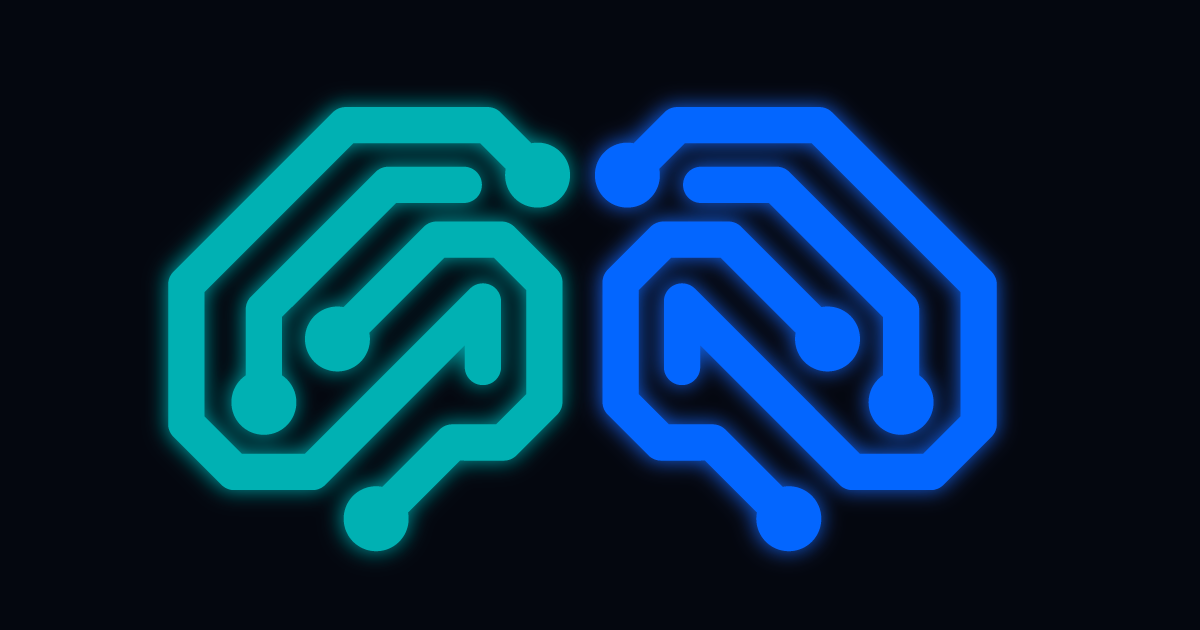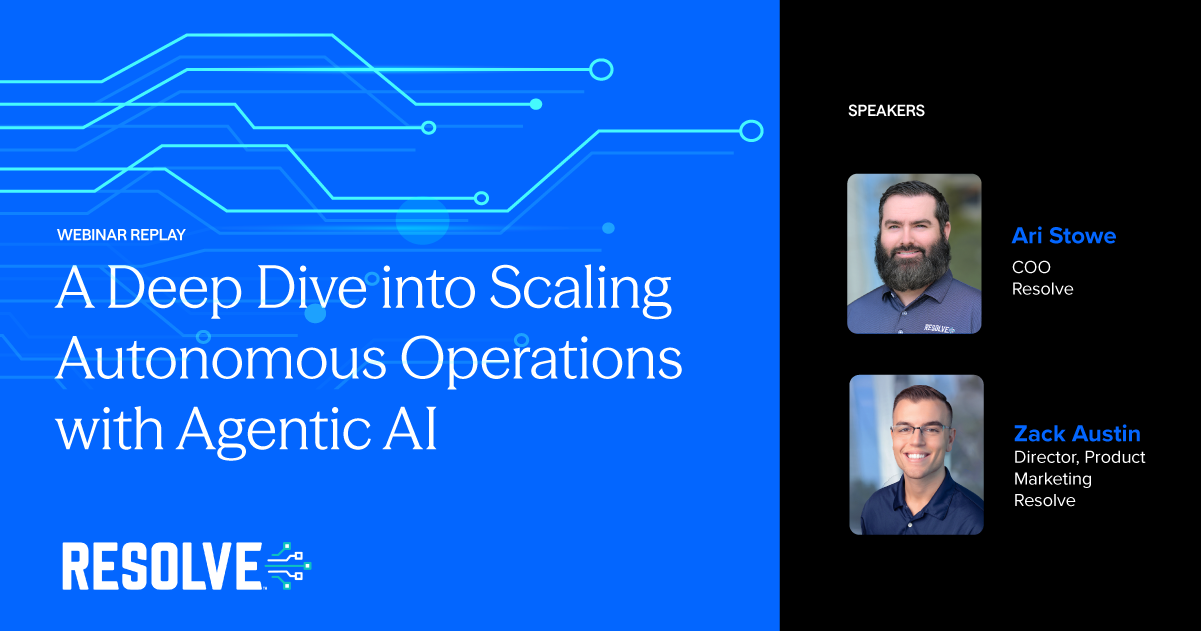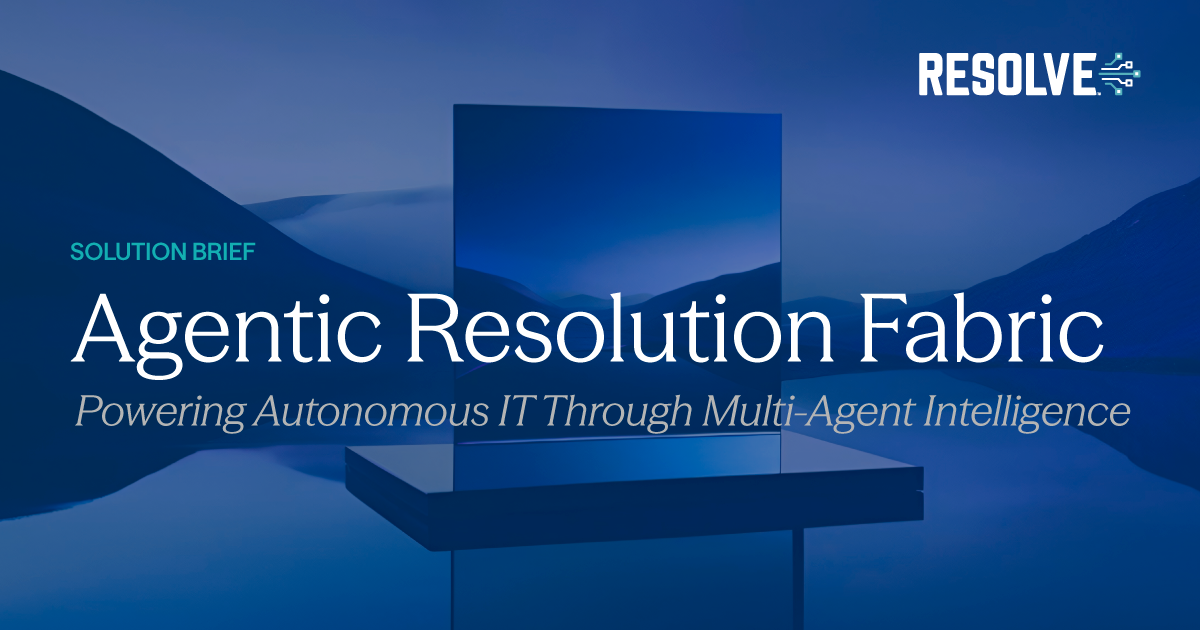
Resolve Demo Express: From Alerts to AI
Subscribe to receive the latest content and invites to your inbox.
The phrase "demo express" is no accident or exaggeration, because when it comes to IT process automation, it's all aboard.
Organizations across every vertical contend with a wide variety of IT challenges, such as: costly downtime, large ticket volumes, or a disjointed digital environment made up of many different apps and devices. The challenge is immense, and so too is the business success potential for teams that can harness process automation.
Fortunately, no matter where you're at in your process automation journey, Resolve Systems is ready to show our groundbreaking AI-powered technology in action. Our recent demo express was a chance to pull into the station and have our experts exhibit how we solve your most pressing process automation challenges. Let's take a ride!
Use Case One: Hasta la Vista, Downtime!
One of the most essential components in any IT ecosystem is efficient alert remediation, whether it's done automatically or manually. When teams take too long to respond to alerts like high network latency, the result can be costly downtime that can profoundly impact customer experience and, ultimately, the bottom line.
In the modern IT landscape, though, it's not enough to have monitoring that can quickly detect issues and symptoms on time. Infrastructure and network teams also need to be able to triage, run thorough diagnostics to pinpoint the root cause, and quickly remediate the issue by applying the right fix.
That's the train-sized benefit of Resolve's automation expertise: automation and orchestration that can quickly remediate a fault as soon as it's detected, empowering IT teams to reduce MTTR, focus on big-picture tasks, and ultimately supercharge their operations.
Network Latency Remediation in Action
This automation use case showcases how a Resolve workflow can efficiently diagnose and resolve network latency issues between an application server and a database server.
The automation workflow gets triggered as soon as the alert comes in, conducting a series of diagnostic checks, including ping latency, interface statuses, packet errors, and CPU utilization on the intermediary network switch. Once the workflow identifies the root cause as high CPU utilization, it automatically (and safely) reboots the device, restoring normal performance.
The entire process is documented in real time, with automated ticket creation, detailed remediation logs, and alerts sent via Slack and Teams to keep infrastructure and network teams informed. In short, this use case demonstrates how automation can streamline network troubleshooting and reduce downtime.
Those capabilities comprise the first stop on our demo express, but the ride's far from over; hasta la vista, downtime!
Use Case Two: AI to Infinity and Beyond
The term "AI" refers to so many different things, but within the context of IT, it's a power source that you and your team can leverage to meaningfully improve your outcomes. That's the next stop on our journey today, and if hearing "AI" conjures images of user-unfriendly systems and costly data engineering, don't worry—our approach entails neither.
Resolve's approach to AI is to empower teams to seamlessly integrate tools like ChatGPT into their existing process automation. When this happens, your AI tool of choice can communicate with your existing software and auto-generate recommended fixes when an issue arises!
Using AI to Left-Shift Resolutions
This use case highlights how automation integrates with LLMs like ChatGPT to enhance IT process automation.
In this example, a network bandwidth issue is detected, and a ticket is generated and categorized—this triggers the Resolve automation workflow. The system queries ChatGPT for the next step. ChatGPT queries all existing similar tickets for their close notes to determine the cumulative steps taken to solve the problem.
The next step is for the L1 engineer to utilize the diagnostic recommendations, validate that suggested commands are safe for execution, and then run them via SSH, automatically updating the ticket with structured results. This approach eliminates the need for escalation, allowing L1 operators to receive and execute actionable insights safely. Every step of these workflows is guard railed to allow for human intervention at any time.
The benefits of incorporating language learning models into your process automation and workflows are profound. They save your team a massive amount of time in identifying and solving for problems, and they present their solutions in readable, easy-to-follow ways. It's an approach that allows for minimal human intervention without sacrificing an iota of oversight capabilities.
And now, without further ado, it's time to pull into the final station of Resolve's demo express: meaningfully improved alert response.
Use Case Three: The Alert is Just the Beginning
Receiving an incident alert is one thing—getting a holistic, 360-degree view of how it happened and orchestrating workflows across the different applications to remediate it is another.
Bringing a Web Application Back Up
This automation use case showcases how Resolve Actions streamlines incident response for infrastructure and networking teams.
When an alert indicates that a hosted web application is unreachable, an automated workflow is initiated to diagnose and remediate the issue. The workflow automatically creates a ticket, updates the monitoring tool, and proceeds with diagnostics, triage, and root cause analysis. As soon as the alert is generated, the automation workflow efficiently identifies and resolves issues without manual intervention, reducing downtime and ensuring a swift, consistent incident response.
With Resolve, the problem of slow, manual response is left to rust in the railyard, as IT teams can use our capabilities to unite apps, alerts, and configurations out of the box. The result? Teams don't need to waste time verifying where an alert happened, where the ticket lives, and what's being done to solve the problem. Everyone is granted a single, holistic view of both the issue and its resolution, saving time on chasing fragmented updates. This capability meshes well with tools that reduce resolution downtime and the need for time-consuming human intervention.
The Demo Express Roundup
Managing your entire IT ecosystem can feel like jumping the tracks, but with Resolve Systems on your side, you will never end up on the wrong side of them.
Each of the tools we've touched on in this demo express are greater than the sum of their parts, ultimately enabling a meaningfully improved experience for your IT teams, your non-IT employees, and the customers that your entire organization works so hard to serve.
So, with that, our demo express reached the end of the line. Click here to see more of this locomotive in action, and we hope you'll ride with us again soon!






